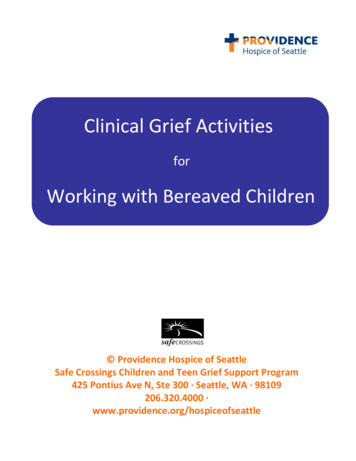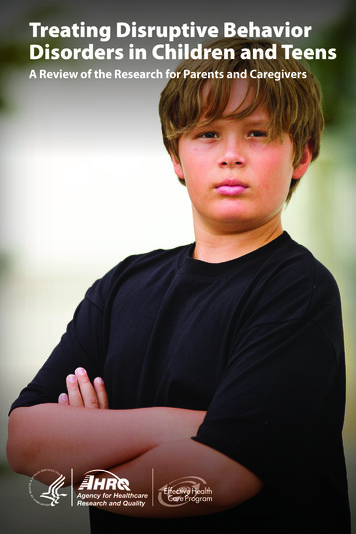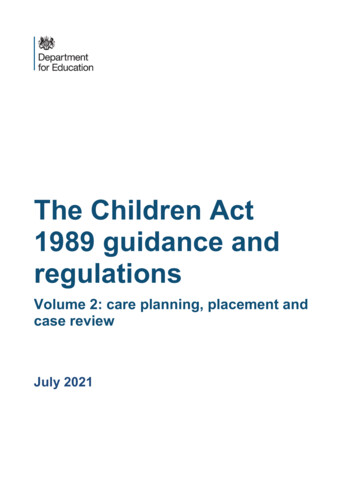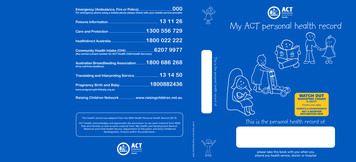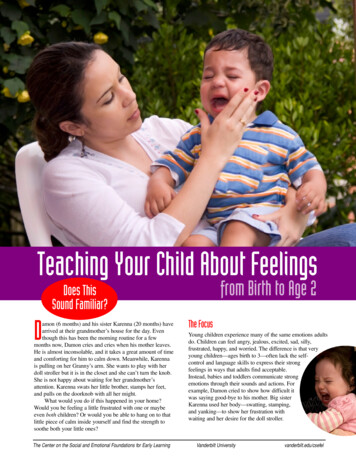
Transcription
Teaching Your Child About Feelingsfrom Birth to Age 2Does ThisSound Familiar?Damon (6 months) and his sister Karenna (20 months) havearrived at their grandmother’s house for the day. Eventhough this has been the morning routine for a fewmonths now, Damon cries and cries when his mother leaves.He is almost inconsolable, and it takes a great amount of timeand comforting for him to calm down. Meanwhile, Karennais pulling on her Granny’s arm. She wants to play with herdoll stroller but it is in the closet and she can’t turn the knob.She is not happy about waiting for her grandmother’sattention. Karenna swats her little brother, stamps her feet,and pulls on the doorknob with all her might.What would you do if this happened in your home?Would you be feeling a little frustrated with one or maybeeven both children? Or would you be able to hang on to thatlittle piece of calm inside yourself and find the strength tosoothe both your little ones?The Center on the Social and Emotional Foundations for Early LearningThe FocusYoung children experience many of the same emotions adultsdo. Children can feel angry, jealous, excited, sad, silly,frustrated, happy, and worried. The difference is that veryyoung children—ages birth to 3—often lack the selfcontrol and language skills to express their strongfeelings in ways that adults find acceptable.Instead, babies and toddlers communicate strongemotions through their sounds and actions. Forexample, Damon cried to show how difficult itwas saying good-bye to his mother. Big sisterKarenna used her body—swatting, stamping,and yanking—to show her frustration withwaiting and her desire for the doll stroller.GREENSPAN’S FIVE ESSENTIALVanderbilt Universityvanderbilt.edu/csefel
What to Expect: Social and Emotional SkillsSometimes it is hard to imagine that very young babies are actively learning all the time, especially when they seem to spendmost of their time sleeping, spitting up, or dropping strained carrots off the side of the high chair. However, these early yearsare a critical time of learning for babies and toddlers. They are developing a foundation of social-emotional skills that theywill build on for the rest of their lives. Here is a table that highlights the social-emotional skills your child is learning andpracticing at different ages. You can use this information to track how your child is growing and changing from birth to age 3.GREENSPAN’S ESSENTIAL DEVELOPMENTAL STAGESDevelopmental GoalAge Range1Stage One:Being Calm and Interestedin All the Sensations of theWorldApproximatelybirth to 3 monthsApproximately2 to 10 monthsApproximately3 to 10 monthsYour baby is: purposefully using gestures (facial expressions, actions, andsounds) to communicate. responding to others’ gestures with gestures of his own. realizing that he can use sounds and gestures to get hisneeds met by loved caregivers.3Stage Three:Becoming a Two-WayCommunicator4Stage Four:Learning to SolveProblems and Discoveringa Sense of SelfApproximately9 to 18 months5Stage Five:Creating IdeasYour baby is: learning how to be calm, how to accept soothing andcomfort from a loved caregiver. learning to feel secure and interested in the world aroundhim. trying to organize the information he is receiving from hissenses.Your baby is: becoming more focused on parents and other persons andthings outside herself. expressing emotional reactions of her own (e.g., smiles andfrowns). expressing pleasure in others’ company.2Stage Two:Falling in LoveWhat’s Happening?Approximately16 to 36 monthsYour baby is: learning to solve problems, like how to stack blocks in atower. communicating in increasingly complex ways, usinglanguage, expressions, and gestures. learning what to expect from others, based on interactionsand experiences with parents and caregivers. developing a sense of self.Your toddler is: becoming skilled in symbolic thought (e.g., labeling imageswith words: “Cookie!”). using verbal means to communicate needs and desires. engaging in pretend play. learning to recognize and communicate her feelings. learning to understand others’ feelings.(Greenspan 1999)The Center on the Social and Emotional Foundations for Early LearningVanderbilt Universityvanderbilt.edu/csefel
Good Habits to Get IntoPractice Makes PerfectFrom birth to age 2, parents and caregivers have a big part toplay in helping children learn about feelings. The mostimportant thing they can do is meet their babies’ needs, loveand nurture them, and comfort them when they are upset.This type of responsive care helps very young children builda strong, loving relationship with the adults who care forthem. Feeling safe and secure, loved and nurtured, is thebiggest and most important ingredient for a child’s healthysocial-emotional development.There are other things that you can do to help your babyor young toddler begin to learn about feelings and how toexpress them. These are all good habits to develop whileyour child is young so that they become part of youreveryday interactions and routines.Children from birth to age 2 are learning a lot aboutrelationships, feelings, soothing, and self-control. Here aresome activities and strategies you can use with your child tohelp him or her begin to understand these big ideas: Think about your child’s temperament, or the way inwhich she approaches and reacts to the world.Temperament influences how intensely your childexperiences feelings (like frustration or anger) and howeasily she can calm down. A child who has strong feelingsand reactions might have a harder time learning to controlher emotions. Strong feelings probably feel even biggerand more overwhelming to her. On the other hand, a childwho is easy going and allows changes or disruptions to“roll off her back” will probably have an easier time.Think about your own temperament. There is no “right”or “wrong” way to be. But paying attention to your ownand your child’s temperament gives you importantinformation about each of your preferences. You can learnhow to adjust or match your caregiving to meet yourchild’s needs and help her grow and learn. Talk about feelings. At first, babies and young toddlerswill probably not understand when you say, “I can seeyou are angry because Jessie knocked your blocks over”or “You are so sad that your balloon flew away.” It mighteven feel a little silly to talk to a tiny baby about hisfeelings. But this is an important part of helping yourchild learn to identify and describe his emotions. Whenyou use feeling words over and over as your child grows,he will eventually come to understand what you mean. Asyour child’s language skills develop, he will start to usethese words on his own.From Birth to 18 Months Keep your baby close. Put on some of your favoritemusic, pick up your baby, and gently sway to the beat.Gaze into your baby’s eyes, smile at her, and hold her nextto your body. Leave the infant carrier in the car sometimesand hold your baby instead as you walk through the mallor visit a friend. Cuddle and nuzzle your baby during someone-on-one time before bed. Shared moments like thesehelp build a strong bond between the two of you. Read or tell stories about feelings. Choose books withbrightly colored illustrations or pictures and not too muchtext. Stories help your baby begin to understand emotionslike frustration, anger, pride, and joy. As you read, point tothe faces in the book and say, “She looks excited. He lookssurprised.” As your child grows, you can ask: “Who is sadon this page?” When he is able to talk, you can ask, “Howis that baby feeling?” Make baby-safe puppets. Cut some pictures of babiesand adults from magazines or catalogs. Choose picturesthat show a range of emotions. You can also use familyphotos. Glue these to sturdy cardboard. If you’d like, youcan cover them in clear contact paper so your baby candrool on them! Let your baby choose a face to look at. Lether look at the picture for as long as she’d like. Talk aboutthe picture as your baby gazes at it: “That baby is crying.He is sad.” Or, “That baby is laughing. He is happy to playwith his puppy.” Play peek-a-boo. Beginning at about 6 to 9 months,babies really enjoy peek-a-boo. Label your baby’s feelingsas you play: “Uh oh, where’s Mommy? Here I am—Peeka-boo! Are you surprised? Are you happy to findMommy?” Games like peek-a-boo are also ways you canpractice separations, reassuring your child that “I might goaway, but I come back.” Be a role model for expressing strong feelings inhealthy ways: “I just spilled your cup of juice all over thefloor! I am feeling really frustrated. I think I am just goingto close my eyes and count to five before I clean up.”Through your words and actions, you can show your childhow to manage strong feelings and recover. And whenyou are having a hard time, it’s okay to make sure yourchildren are in a safe place and give yourself a couple ofminutes to calm down. You are modeling self-control andshowing that sometimes you need a break, too.The Center on the Social and Emotional Foundations for Early LearningVanderbilt Universityvanderbilt.edu/csefel
Look in the mirror. Babies don’t really know it’s them inthe mirror until they are about 2 years old. But you canhelp them become familiar with their own faces bymaking baby-safe mirrors part of your play. As the two ofyou look at your reflections, point to your smile and say,“I am so happy. I am happy because I love being herewith you!” Watch to see how your child responds to sounds andtextures. Use different sounds (rattles, toy pianos,shakers) and textures (towel, blanket, a square of lace, apiece of sandpaper, etc.) during playtime with your baby.Watch how your child responds. What does he like?Dislike? How much stimulation is too much for him?How do you know when your baby has had enoughplaytime (does he cry, look away, fall asleep, etc.)?Information like this helps you understand his needs andmake him feel safe and comfortable. Help your child recover when feelings getoverwhelming. How does your child like to be soothed?You can try swaddling, or snugly wrapping your baby ina blanket. Giving your baby a pacifier to suck, rocking,and singing can also help soothe little ones. For childrenover age 1, a cuddly stuffed animal or special blanket cancomfort and calm them. Does your toddler need timealone to calm down? A firm hug or cuddle time, a changeof scenery, a chance to jump up and down, or somephysical play can also help toddlers recover. When youhelp soothe your young child, you are not “spoiling.”Instead, you are teaching your child that she can dependon you. Children are also learning what to do to makethemselves feel better when they get overwhelmed—alifelong skill. Know that your baby senses how you are feeling.Research has shown that babies watch their loved onesvery closely and respond to the feelings of the peoplearound them. They know when you are upset, angry,stressed, or worried, even when you are trying very hardto hide it. They can feel your arms holding themdifferently when you are stressed and they are able torecognize that although you are smiling, your eyes aresad. So it’s very important to take care of yourself so thatyou can take good care of your baby and help him feelsafe, secure, and loved.Taking Care of YourselfWe all feel stressed and overwhelmed at times.Thinking about what makes you feel calmer and morerelaxed gives you an idea of what you can do when the goinggets rough. You might try asking a trusted adult to watch yourchild for a little while so you have some time to yourself;exercising; writing in a journal; talking to a friend, counselor, orhome visitor; or connecting with other parents. When you are aparent, it can be easy to forget that you need to be nurtured,too. But you do! Parenting can be hard work at times andall parents need and deserve support.The Center on the Social and Emotional Foundations for Early LearningFrom 18 Monthsto 2 Years Use pretend play as a chance totalk about feelings. Your young toddler is just beginning toplay pretend. You can help her develop this important skillby using a doll or stuffed animal in your play. Ask yourchild, “Doggie is sad because he fell down and got a bump.What can we do to make Doggie feel better?” This helpsyour child think about others’ feelings, a quality called“empathy.” Make a homemade book about feelings. Toddlers lovelooking at photos of you, themselves, and their friends. Snapsome photos of your child when he is happy, silly, tired,excited, etc. Glue each photo to a piece of sturdy paper orcardboard. Write a feeling word under the photo, punchholes in the pages, and tie together with yarn. Let your child“read” the book to you and tell you how he is feeling ineach photo. Use songs to practice feeling words. Your child’s languageis just beginning to take off, so give her a fun way topractice by changing the words to songs like “When You’reHappy and You Know It.” Try adding new verses like,“When you’re angry and you know it, stomp your feet,”“When you’re sad and you know it, get a hug,” “Whenyou’re cranky and you know it, find your Teddy,” etc. Make a cozy place in your home. Just like adults, childrensometimes need time alone to calm down. Give your child aspace to do this by piling up some soft cushions andblankets, and adding a few stuffed animals and favoritestories. You can even get a large moving box, cut a door,and create a toddler-size “cozy room.” Encourage your childto use this place when he is feeling overwhelmed or justwants some quiet time. Suggest ways to manage strong emotions. We often telltoddlers what not to do (e.g., “No screaming” or “Stophitting”). Telling toddlers what they can do to express bigfeelings is even more important. When your child is reallyangry, suggest that she jump up and down, hit the sofacushions, rip paper, cuddle up in a cozy area for alone time,paint an angry picture, or some other strategy that you feelis appropriate. The goal is to teach your child that anyemotion is okay to feel and that she can learn to expressfeelings in healthy, non-hurtful ways. Empathize with your child’s feelings. Sometimes thechoices your child is being offered are not the ones he wants.Because your reaction gives him a cue of how to respond,it’s best to stay matter-of-fact when you explain: “I know thatVanderbilt Universityvanderbilt.edu/csefel
Pow! Bam! Take That! And That!As you watch your child playact a battle betweentwo action figures, your impulse might be to stop thisaggressive play. But this is very typical for the toddler years.you do not want the Plan for tantrums.Play is the perfect time for children to work out strongdoctor to give you aTantrums are veryfeelings, even difficult ones like anger, frustration, or fear.shot. You are feelingcommon in the toddlerWatching children as they play, and playing with them, helps youreally worried. But theyears because childrenunderstand what they are thinking about or struggling with. Youshot keeps you healthy.are still learning—andcan also get insight into where they need a little support andIt will hurt a little, but notsometimes reallyhow you can help them make sense of the world aroundtoo much. And it will bestruggling—with managingthem. If an upsetting play theme continues for a while orover with very quickly.”and expressing their feelings.you are worried about your child’s play, talk withThis helps your child copeTantrums are their way ofyour child’s health care provider, teacher orand, hopefully, move on.saying, “I am out of control andcaregiver, or a child development Help your child understand herneed your help to calm down.”specialist.feelings and behavior. When you canRather than getting angry, too (which ismake connections between your child’stemperament and her feelings, it helps her learn aboutherself. For example, you might say to a child who has ahard time moving between activities, “It’s hard for you toget ready for nap right after we finish lunch. Your bodyneeds time to relax after playing and eating. I will helpyou settle down and start to feel sleepy. Let’s choose astory and get cozy.” Over time this helps your child learnto manage situations that are challenging for her.Teaching Feeling WordsWe often think only of teaching wordsfor common emotions like happy,sad, mad, etc. But there aremany, many other feelingwords that we can use todescribe the range ofcomplex emotions each ofus (and our children)experience every day.Children benefit when theydevelop a “feelingsvocabulary” that they can use tocommunicate what they are feelingand experiencing. While babies andtoddlers won’t understand these words right away, over timeand with practice they will grasp their meaning and begin touse these words themselves. Here are some isedSillyUncomfortableStubbornThe Center on the Social and EmotionalFoundations for Early yeasy to do, but can be scary for your child), helpyour child recover. Here’s what you can try:1. Put into words how you think your child is feeling: “Youare really mad. You are so frustrated!”2. Give him a way to show his strong feelings: “Do youwant to throw some pillows?”3. Give him the support he needs (hugs, time alone, histeddy, etc.) to recover.4. Suggest another activity to shift his energy to somethingpositive: “Let’s play with blocks.”5. And, as hard as it is sometimes, try to stay calm duringyour child’s tantrums. You teach your child self-control bystaying calm when he has “lost it.” This helps him feelsafe and lets him know that you’ll always be there tosupport him—even during the tough times. Offer choices. Choices give toddlers a sense of control andcan help them cope with disappointment. You might say, “Itis bedtime. But you can choose whether you put pajamas onfirst or whether you brush teeth first.” Choices can also helpchildren deal with angry feelings and move on. For example,during a tantrum, you might say, “I can see you need to cryright now. Would you like me to hold you or do you want tobe alone?”Putting It All TogetherUnderstanding feelings is an important part of a child’s socialemotional development. Babies and toddlers experience feelingsjust like you do, and know when you are feeling happy or downas well. When you use words to describe emotions, share intheir good feelings, and comfort them when they feel sad oroverwhelmed, young children are learning important socialemotional skills. This learning takes a lot of practice on theirpart, and a lot of patience on yours. But the time and effort areworth it. The social-emotional skills children develop in the firsttwo years are ones they will use and build on for the rest of theirlives.Reference: Greenspan, S. (with Breslau Lewis, N.). (1999). Buildinghealthy minds: The six experiences that create intelligence and emotionalgrowth in babies and young children. Cambridge: Perseus Books.Child CareBureauOffice ofHead Start
the picture as your baby gazes at it: "That baby is crying. He is sad." Or, "That baby is laughing. He is happy to play with his puppy." Play peek-a-boo. Beginning at about 6 to 9 months, babies really enjoy peek-a-boo. Label your baby's feelings as you play: "Uh oh, where's Mommy? Here I am—Peek-a-boo! Are you surprised?
